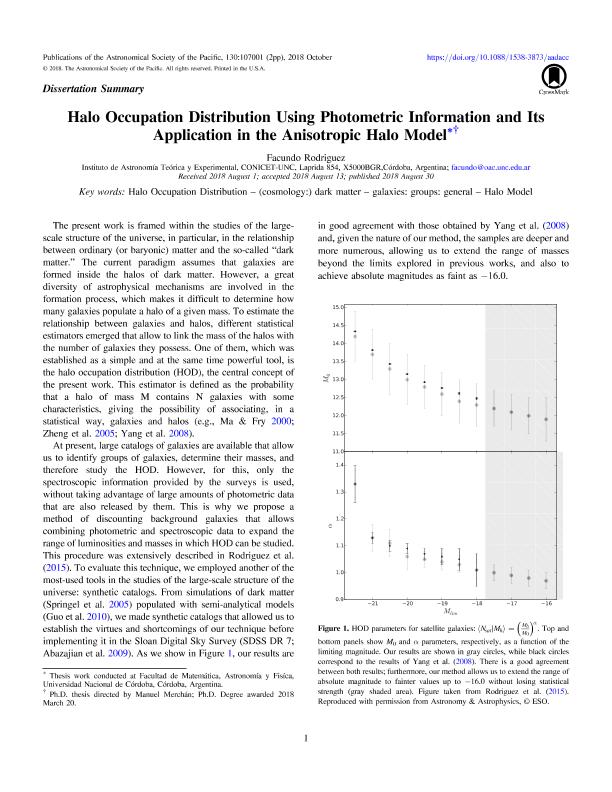Artículo
Halo occupation distribution using photometric information and its application in the anisotropic halo model
Fecha de publicación:
10/2018
Editorial:
Institute of Physics Publishing
Revista:
Publications of the Astronomical Society of the Pacific
ISSN:
0004-6280
e-ISSN:
1538-3873
Idioma:
Inglés
Tipo de recurso:
Artículo publicado
Clasificación temática:
Resumen
The current paradigm assumes that galaxies are formed inside the halos of dark matter. However, a great diversity of astrophysical mechanisms are involved in the formation process, which makes it difficult to determine how many galaxies populate a halo of a given mass. In order to estimate the relationship between galaxies and halos, different statistical estimatorsemerged that allow linking the mass of the halos with the number of galaxies they possess. One of them, which was established as a simple and at the same time powerful tool, is the halo occupation distribution (known in Spanish as DOH), the central concept of the present work. This estimator is defined as the probability that a halo of mass M contains N galaxies with some characteristics, giving the possibility of associating, in a statistical way, galaxies and haloes. At present, large catalogues of galaxies are available that allow us to identify groups of galaxies, determine their mass and then study the DOH. But, for this, only the spectroscopic information provided by the surveys is used, without taking advantage of large amounts of photometric data that are also released by them. That is why, one of the objectives of this work was to propose a method of discounting background galaxies thatallows combining photometric and spectroscopic data to expand the range of luminosities and masses in which DOH can be studied. To evaluate this technique we employed another of the most used tools in the studies of the large-scale structure of the universe: synthetic catalogues. From simulations of dark matter populated with semi-analytical models we made synthetic catalogues that allowed us to establish the virtues and shortcomings of our technique before implementing it in the Sloan Digital Sky Survey (SDSS) catalogue. Another of the objectives that we proposed in this thesis was to compare the DOH with other estimators. In particular, we compared it with the mass-richness relation obtained from gravitational lens studies. For this we worked with other researchers, who measured the mass and richness of a sample of groups and we, using the technique mentioned in the previous paragraph, determined the DOH of said sample. But, since both estimators are not directly comparable, we use the same determinations but we modify the calculation of the DOH to be able to make the comparison. We obtained great agreement between both estimates.The third central theme of our work was to incorporate the DOH to the halo models. These allow to explain the density fields. More precisely, by numerically developed halo models, the correlation function of dark matter can be reproduced. If DOH is incorporated into these models, the density fields of baryonic matter can be reproduced. In this thesis we use the DOH estimates and incorporate the anisotropic model of halos. We evaluated the feasibility of incorporating DOH into this model through synthetic catalogues and determined, in addition, estimates of the shape of dark matter haloes for different mass ranges.
Archivos asociados
Licencia
Identificadores
Colecciones
Articulos(IATE)
Articulos de INST.DE ASTRONOMIA TEORICA Y EXPERIMENTAL
Articulos de INST.DE ASTRONOMIA TEORICA Y EXPERIMENTAL
Citación
Rodriguez, Facundo; Halo occupation distribution using photometric information and its application in the anisotropic halo model; Institute of Physics Publishing; Publications of the Astronomical Society of the Pacific; 130; 992; 10-2018; 1-2
Compartir
Altmétricas




